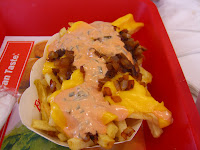
Oh hail king of burgers. I bow before your might, the glory of your patties, the joy of your special sauce, the freshness of your greens, the vivid shine of your reds, and the toasty bite of your perfect, beautiful buns.
Straight from Socal we have the In-n-out burger. For those of you unfortunate cretins who don't know what In-n-Out is (blasphemer!), it's the fast food joint that makes all other fast food joints look like hapless pieces of shit wrapped in week-old endometrial fluid from a coat-hangered fetus chillin in a pool of NYC subway sewage.
Good luck getting that image out of your head.
In-n-Out is an exclusive chain that limits itself to the West Coast. They serve burgers, fries, milkshakes, and soft drinks in all manner of fashion. They feature a "secret menu" that further elaborates on the regular offerings--triple, quadruple, quintuple patties, "animal" fries, "animal" burgers, extra this, or extra that. It's one hell of a joint.
Did I mention that it's delicious?
Taste:
The best burger I have had (followed by the Royal Red Robin at Red Robin. Can't really go wrong with egg on top of hamburger). Juicy, tasty, fresh, awesome texture...I run out of adjectives, so I'll just describe the ingredients for you.
The key to In-n-Out's success (in my opinion) lies with those fresh ingredients. Their lettuce has a crisp crunch to it. Their tomatoes are remarkably flavorful--much moreso than the crap you get at McD's. Of course, that's not to play down how well they can handle their patties--juicy, dripping, an absolutely delicious mess. In-n-Out is also one of the few burger joints that pays careful attention to toasting their buns. This I think, adds a great deal to their texture, and the overall experience. Not only do you not get caught up in a soggy bun, but there's that delectable crunch that you get with every bite.
The sauce they use is an orange thing, perhaps a combination of mayonnaise, ketchup, and thousand island dressing. It's a very nice, subtle solution that seals all the ingredients together quite pleasurably.
And here's a picture of animal fries:
 So they put their special sauce on some fries (same sauce as their hamburgers), cheese, and lots of grilled, diced onions. Your girlfriend may not kiss you after eating this, but your mouth will love you forever. Their fries are made fresh (you can see some poor schmuck in the back cutting up potatoes), and the taste shows it. Each fry is crisp. Not a limp one; none overdone with oil either. I never thought there were such things as "good" fries till In-n-Out before.
So they put their special sauce on some fries (same sauce as their hamburgers), cheese, and lots of grilled, diced onions. Your girlfriend may not kiss you after eating this, but your mouth will love you forever. Their fries are made fresh (you can see some poor schmuck in the back cutting up potatoes), and the taste shows it. Each fry is crisp. Not a limp one; none overdone with oil either. I never thought there were such things as "good" fries till In-n-Out before.Reflections:
Would do again. Many times. This alone is reason to go to California, and I know many people who will support me in saying that. An awesome, awesome experience. Here's a little tidbit too:
 Every drink cup at In-n-Out gets a Bible verse! Fascinating huh. Them Christians! They be getting into our foods!
Every drink cup at In-n-Out gets a Bible verse! Fascinating huh. Them Christians! They be getting into our foods!










































